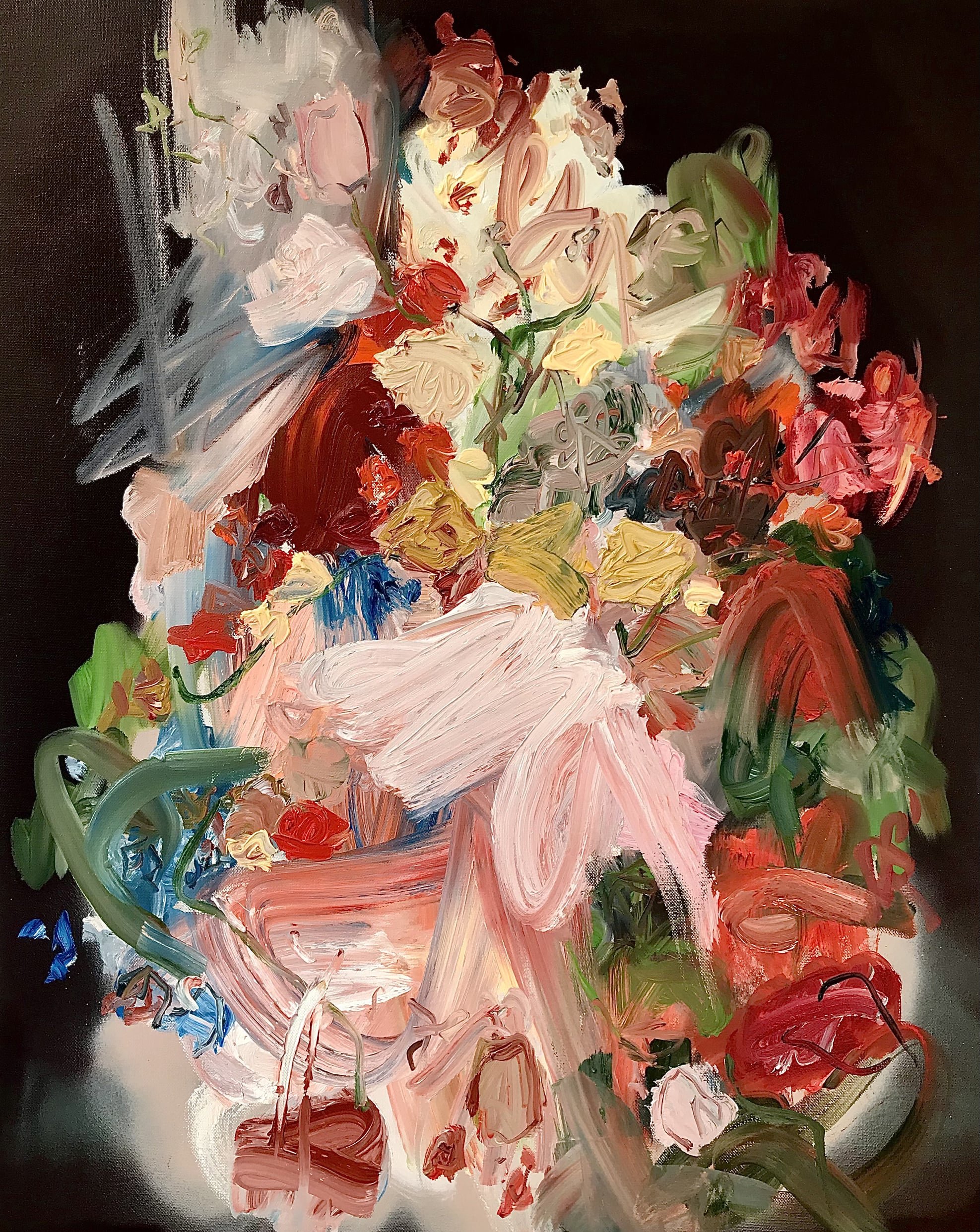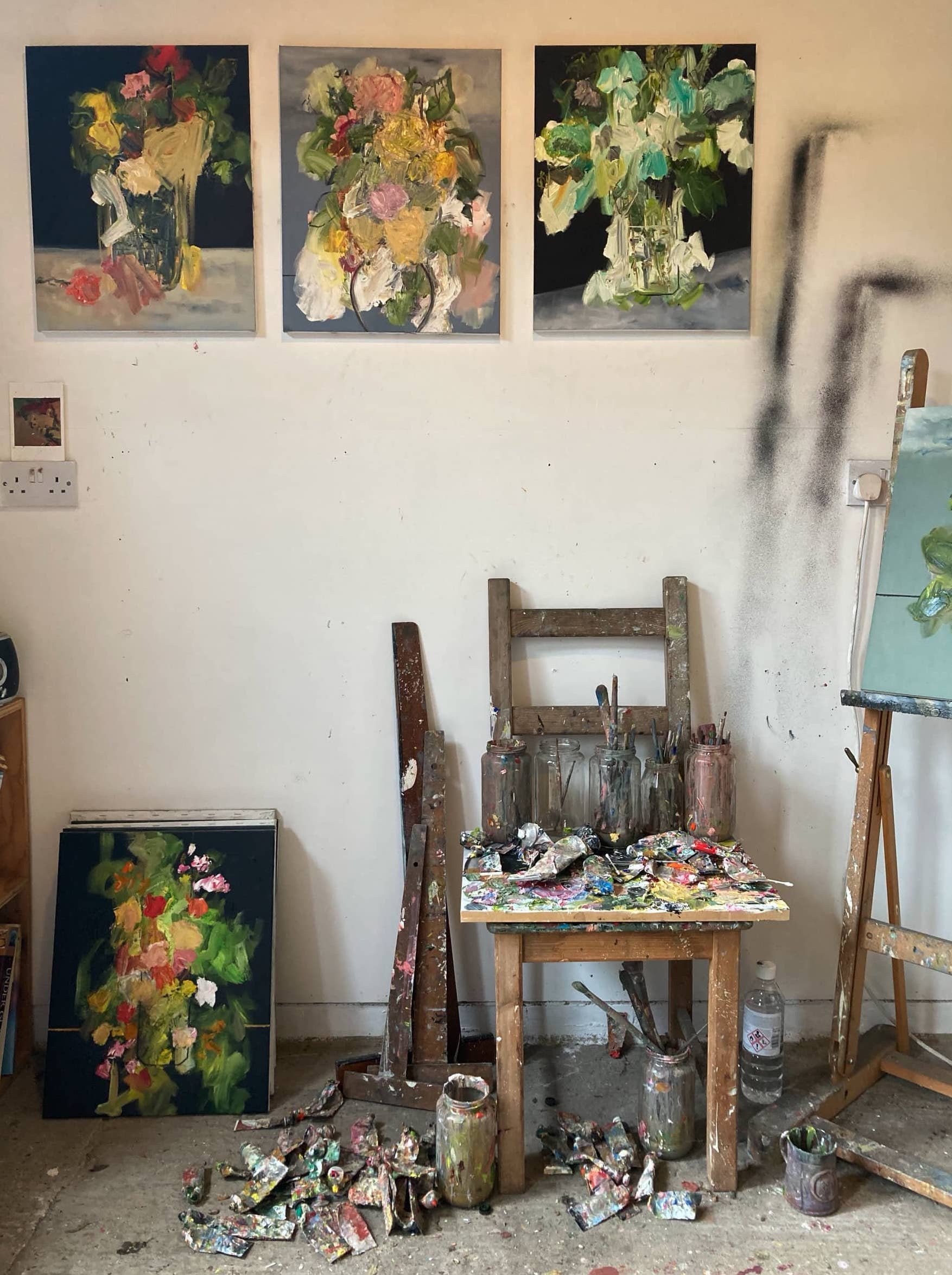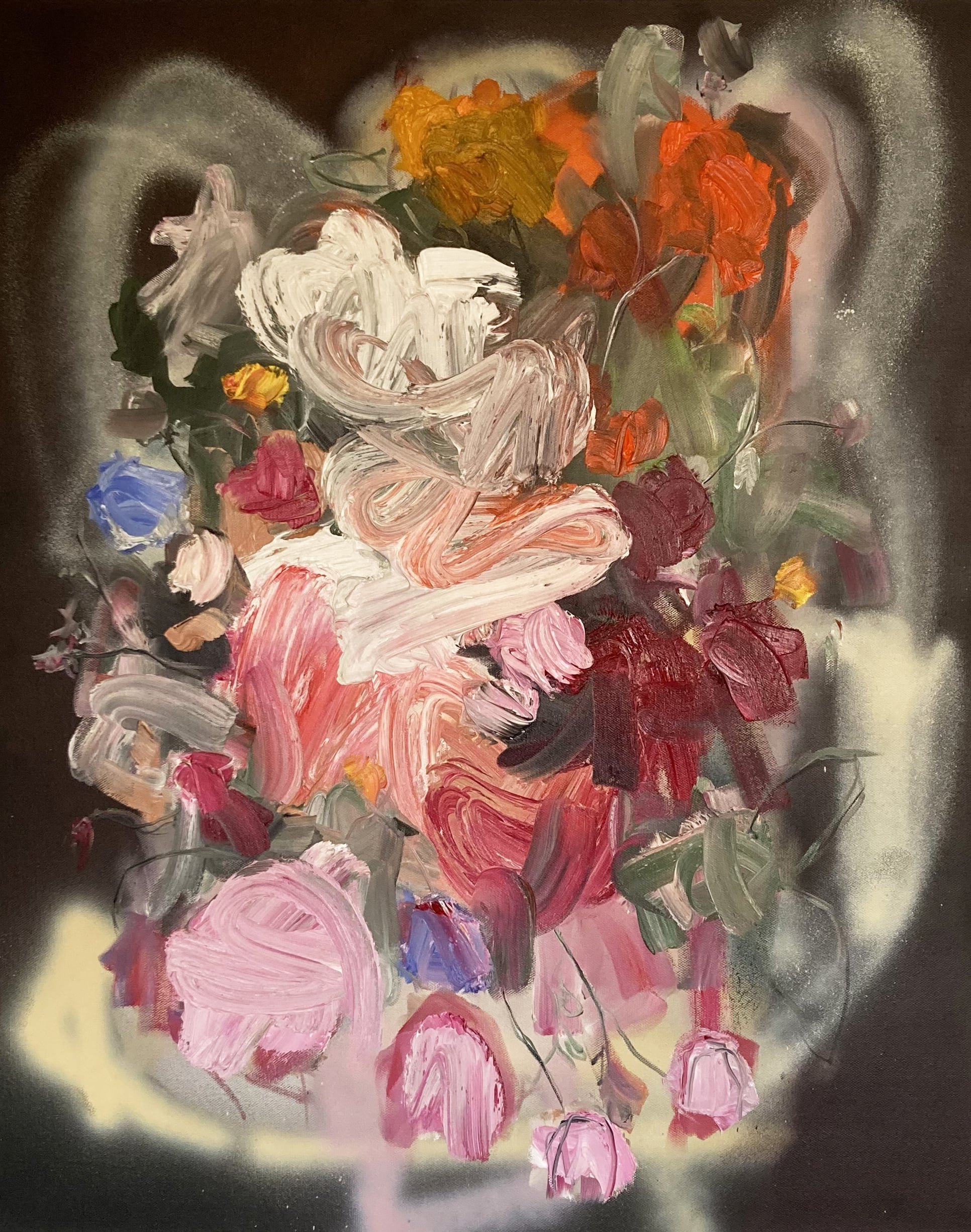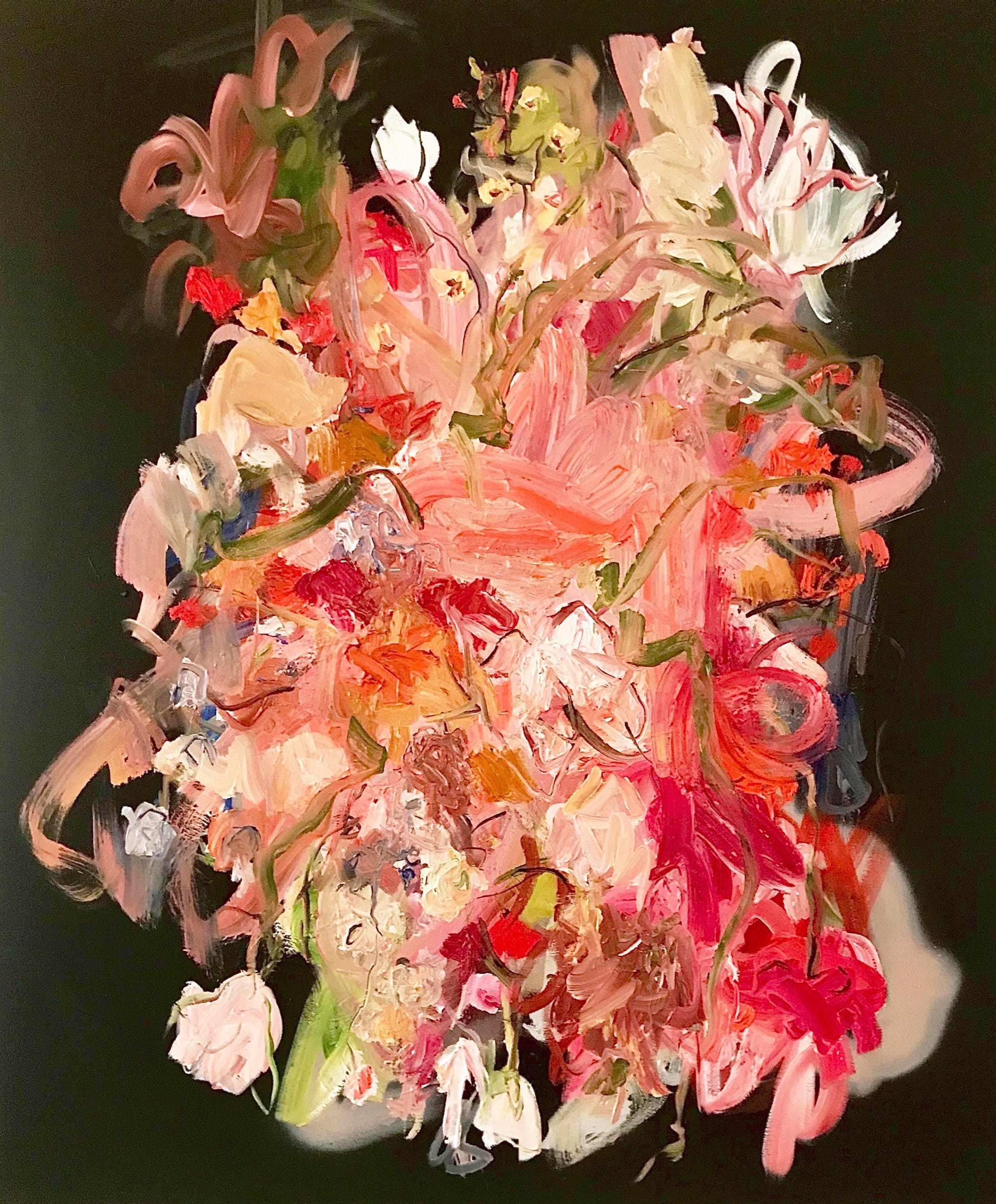Miranda Boulton in her studio
Photo courtesy of the artist
Damaris Athene: Can you start off by telling me about yourself?
Miranda Boulton: I'm a painter. I live and work in Cambridge. I grew up in Suffolk. At school my two loves were art and history. Both my grandparents on my father's side were artists. My grandpa died before I was born, but my Granny kept his studio as it was when he was last in there. When we visited, I would sit in the studio and just look around and stare and imagine him painting. The thought of an artist was very mysterious and amazing to me at that small age. So, when I went to university in Sheffield, I quite naturally did history of art. But I always hankered after the materiality of paint and I knew deep down that's really what I wanted to be doing. Throughout my 20s I did lots of short courses trying out different mediums, but I always came back to paint. At the age of 30, I made a decision that it was time to go for my heart's desire. My husband and I sold off our flat in London and went off traveling for six months. We hired a flat in LA in Hermosa beach for three months and I painted and drew continually. I didn't judge what I did, I just produced work. It was amazing. It absolutely liberated me. I felt like, I'm here and I can't give up now. When we got back, I set up a studio and after my second child was born I started on the Turps Banana correspondence course. It was a perfect vehicle for me. It gave critical input and deadlines. I thought one year would be enough, but three years later I was finally done!
DA: *laughs* Could you say more about your practice?
MB: The dominant part of my practice is looking at art history. For me, my paintings are having a conversation with other paintings from art history. I focus on floral still life imagery and I paint from memory. I spend time looking at these paintings, either in real life, on my phone or in a book, and then, usually the next day, I will start painting based on those memories. I'm trying to distill that memory into a contemporary context or my own visual language. It's acknowledging history, time, space, place. Sometimes it doesn't even look like the painting! I never have an image of the painting I’m referencing with me when I’m painting. I’m pulling on that deep down memory. It can be quite hard and painful. It's an intense exercise to really go inwards in your head. It helps me with the process of painting because I get into a meditative state where I respond instinctually. I think of it like going underwater and above water, you’re sort of aware and then you dip underwater, and when you come back different parts of your brain start to analyse whether the painting is working or not. It’s that flow I’m really interested in. I want the painting to surprise me.
Into the Groove, 2021, Oil paint and acrylic spray paint on canvas, 76 x 61cm
Photo courtesy of the artist
DA: Is that a process that you've developed over quite a long period of time? I'm thinking that maybe the first step would have been to look at the reference images while painting, and then you realised that it was quite constricting?
MB: It was a real mixture. I used to sometimes use them, sometimes not. And then I became aware that, like you say, I felt really restricted having the images there. It's the essence of something I want, not the actuality. The other thing that I’ve realised is really important in my practice is my experience of the surface and the formal elements of the painting. It was quite a jump a couple of years ago, when we went into the first lockdown. I spent much more time going back over paintings and really thinking about them in depth. The speed of the paint, the gestures, the marks, and the tensions on the surface became much more apparent to me.
DA: You also started using spray paint didn't you?
MB: I did. The spray paint is so lovely and buttery and powdery. It was a new tool to play with which made me much more aware of the other elements. I started making built up impasto areas as well because of how beautiful they were next to the spray paint.
DA: That’s great that you were able to have that time to reflect more. How has your painting language developed?
MB: You're influenced by many different artists on your journey as an artist and I suppose each one of them leaves a little imprint on you. You have your core of who you are, how you draw, your experiences and then there's all these different phases you go through, absorbing different influences along the way. I can recognise that gesture might have come from here or that one from there. You develop a toolbox of gestures which become part of your repertoire.
View of Miranda Boutlon’s studio
Photo courtesy of the artist
DA: What draws you to flowers?
MB: To me flowers are poignant. They have the cycle of life. They’re beautiful but have this transience to them. They've got the big life events covered, but then they've also got the every day. It just makes me really happy to paint them. Also, they are a vehicle for an inquiry into the formal elements of painting. I used to paint landscapes and figurative work as well. When I was on the third year of my course, with Turps Banana, I would switch to another genre every time a painting got problematic. I don't think my inquiry was ever overcoming any hurdles. I was just sidestepping them to keep the flow in the studio. I had a fantastic tutor who made me aware of this. She asked me to write ten rules of the studio. I looked at Richard Diebenkorn’s studio notes and made the decision to stick to painting flowers. It was probably the best thing I've ever done, by restricting the subject matter it allowed me to go much more in depth into my practice. Sometimes you feel like you're going around in circles, but you always end up in a slightly different place and I really like that.
DA: What helpful advice from your tutor! How do you usually work? Has it been affected by the pandemic?
MB: Yes, when the pandemic hit I had a studio in North Cambridge and during the first lockdown I just couldn't get there. I converted an outbuilding in our garden into my studio. I love having a studio home now. I think it's the continuity of being able to paint all day and to be able to spend time with the work.
DA: What would you like people to get from your work?
MB: I suppose a sense of emotion. Impasto has a really emotional effect on me. Flowers are life affirming, but they are also transient. I suppose I want to convey beauty, happiness and sadness all at the same time.
Wildflower Soul, 2021, Oil paint and acrylic spray paint on canvas, 76 x 61cm
Photo courtesy of the artist
DA: Have you had any surprising or memorable reactions?
MB: The biggest surprise so far was when I won the Jackson's painting prize! I was bowled over. It was wonderful! It's probably the most positive reaction I’ve had to my paintings.
DA: That's incredible. Congratulations! What's your most unforgettable experience with art?
MB: I went to an exhibition of Richard Diebenkorn’s work at the Royal Academy. I think in 2015. There was something about his work that just hit me. I spent about four hours there and just sat and stared. I was really hit by his confidence to leave areas bare. In his Ocean Park series there are so many mistakes and over drawings. I adored it. It felt such honest work. Nothing was covered up it was so sincere and brave.
DA: Amazing! Which other artists inspire you?
MB: Manet has been a huge influence. I work with his flower imagery a lot. I have such deep memories of so many of his paintings that I don't even need to look at them anymore! Matisse’s use of colour. Francis Bacon, Auerbach and Joan Mitchell. I love the speed and vigour of her gestures. Cy Twombly too. And more contemporary, I really admire Tracey Emin. I love her work and I've read a lot of her books. Una Ursprung too. She uses spray paint in a very different way than I do. Her paintings are so light, airy, and beautiful. Keith Tyson is another one. He does a lot of flower paintings, but they're really detailed. I enjoy his different analytic approach to a similar subject.
Time Will Tell, 2021, Oil paint and acrylic spray paint on canvas, 120 x 100cm
Photo courtesy of the artist
DA: You’ve mentioned so many of my favourites! What have you been working on recently?
MB: I am starting to embark on a few new projects. I finally went to the Ashmolean Museum in Oxford where they have the most incredible room of Dutch and Flemish, still life painting from the 17th and 18th century. I'm starting a new body of work based on memories of those paintings. I’m going to work through these memories very quickly by doing studies on paper. It’s too cold to be in the studio at the moment!
DA: Have you got any shows coming up?
MB: I have a few group shows coming up. I've got one Rye Art Gallery at the end of January. It's specifically a flower painting show. It's going to be nice to see my work alongside lots of other people’s interpretations. I've also got a group show at Studio 1.1 and No Format gallery. I’m doing an Arts Council application. I've been looking at the work of Mary Moser, who was a founding member of the Royal Academy in the 18th century. She was a flower painter, I want to do developing your creative practice application based on researching her work and then responding to it. I'm really excited about it because it brings all my art history research together.
DA: Have you got any other plans for future work?
MB: I've got an exhibition in October looking at poetry and painting. I’m going back throughout my life looking at poetry that has influenced me. I don't know what I'm going to do yet.
DA: It all sounds amazing! I can’t wait to see it all! Thanks so much for sharing your practice with me Miranda.
MB: You’re welcome. Thank you!





